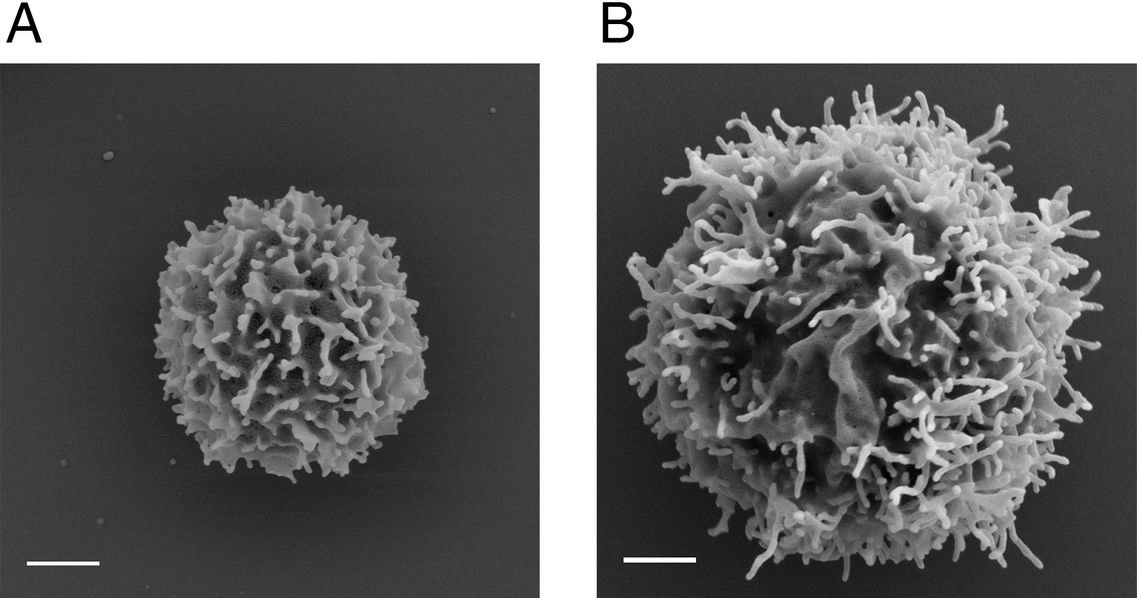Chapter 1 Introduction
1.1 Basic T cell biology
To learn or review basic information about the biology of the adaptive immune system and T cells, the following freely available book chapters may be helpful.
Molecular Biology of the Cell, Chapter 24: The Adaptive Immune System
- Lymphocytes and the Cellular Basis of Adaptive Immunity
- T Cells and MHC Proteins
- Helper T Cells and Lymphocyte Activation
Immunobiology, Chapter 8: T Cell-Mediated Immunity
1.2 Building intuition
Here’s a picture of activated vs. unactivated T cells from (Jung et al. 2016).

Figure 1.1: SEM images of resting (A) and effector (B) peripheral blood human T cells. (White scale bars: 1 μm.)
TCRs are found in the squiggles. They are x size.
Here’s the proportion in circulating blood. Here’s how many come from the thymus per day. Here’s how long they live.
1.3 History of T cell subsets
In 1975, Harvey Cantor and Edward Boyse established the distinction between what we would call today CD4+ and CD8+ T cells (Cantor and Boyse 1975). For a review, see (Chess 2006).
In 1986, CD4+ T cells were further subdivided into Th1 and Th2 cells (Mosmann et al. 1986). For reviews, see (Liew 2002) and (McGhee 2005).
A more complex chapter in the history of T cell subsets involves T suppressor cells and T regulatory (Treg) cells. For reviews of this topic, see (Shevach 2011) and (Bluestone 2017).
In 2003, Th17 cells (Aggarwal et al. 2003) were identified as distinct from Th1 and Th2 cells. For a review, see (Basso, Cheroutre, and Mucida 2009).
In 1999, the distinction between effector memory (Tem) and central memory (Tcm) T cells was established by Sallusto, Lanzavecchia, and colleagues (Sallusto et al. 1999). For more recent reviews, see (Sallusto, Geginat, and Lanzavecchia 2004) and (Kaech 2014)).
Recently it’s become clear that these subsets may be better thought of as traits. For example, CD4+ and CD8+ T cells can both be divided into Tem and Tcm, and there exist CD8+ Tregs and CD4+ cytotoxic T cells. Some authors even claim CD8+ T cells can be divided into Tc1, Tc2, and Tc17 subsets that correspond to the CD4+ Th1, Th2, and Th17 subsets (Mittrücker, Visekruna, and Huber 2014).
References
Jung, Yunmin, Inbal Riven, Sara W Feigelson, Elena Kartvelishvily, Kazuo Tohya, Masayuki Miyasaka, Ronen Alon, and Gilad Haran. 2016. “Three-Dimensional Localization of T-Cell Receptors in Relation to Microvilli Using a Combination of Superresolution Microscopies.” Proc. Natl. Acad. Sci. U. S. A. 113 (40): E5916–E5924.
Cantor, H, and E A Boyse. 1975. “Functional Subclasses of T-Lymphocytes Bearing Different Ly Antigens. I. The Generation of Functionally Distinct T-Cell Subclasses Is a Differentiative Process Independent of Antigen.” J. Exp. Med. 141 (6): 1376–89.
Chess, Leonard. 2006. “The Birth of Functionally Distinct T Cell Subsets.” J. Immunol. 176 (7): 3859–60.
Mosmann, T R, H Cherwinski, M W Bond, M A Giedlin, and R L Coffman. 1986. “Two Types of Murine Helper T Cell Clone. I. Definition According to Profiles of Lymphokine Activities and Secreted Proteins.” J. Immunol. 136 (7): 2348–57.
Liew, Foo Y. 2002. “T(H)1 and T(H)2 Cells: A Historical Perspective.” Nat. Rev. Immunol. 2 (1): 55–60.
McGhee, Jerry R. 2005. “The World of TH1/TH2 Subsets: First Proof.” J. Immunol. 175 (1): 3–4.
Shevach, Ethan M. 2011. “The Resurrection of T Cell-Mediated Suppression.” The Journal of Immunology 186 (7). American Association of Immunologists: 3805–7.
Bluestone, Jeffrey A. 2017. “FOXP3, the Transcription Factor at the Heart of the Rebirth of Immune Tolerance.” J. Immunol. 198 (3): 979–80.
Aggarwal, Sudeepta, Nico Ghilardi, Ming-Hong Xie, Frederic J de Sauvage, and Austin L Gurney. 2003. “Interleukin-23 Promotes a Distinct CD4 T Cell Activation State Characterized by the Production of Interleukin-17.” J. Biol. Chem. 278 (3): 1910–4.
Basso, Alexandre S, Hilde Cheroutre, and Daniel Mucida. 2009. “More Stories on Th17 Cells.” Cell Res. 19 (4): 399–411.
Sallusto, F, D Lenig, R Förster, M Lipp, and A Lanzavecchia. 1999. “Two Subsets of Memory T Lymphocytes with Distinct Homing Potentials and Effector Functions.” Nature 401 (6754): 708–12.
Sallusto, Federica, Jens Geginat, and Antonio Lanzavecchia. 2004. “Central Memory and Effector Memory T Cell Subsets: Function, Generation, and Maintenance.” Annu. Rev. Immunol. 22: 745–63.
Kaech, Susan M. 2014. “Celebrating Diversity in Memory T Cells.” J. Immunol. 192 (3): 837–39.
Mittrücker, Hans-Willi, Alexander Visekruna, and Magdalena Huber. 2014. “Heterogeneity in the Differentiation and Function of CD8⁺ T Cells.” Arch. Immunol. Ther. Exp. 62 (6): 449–58.